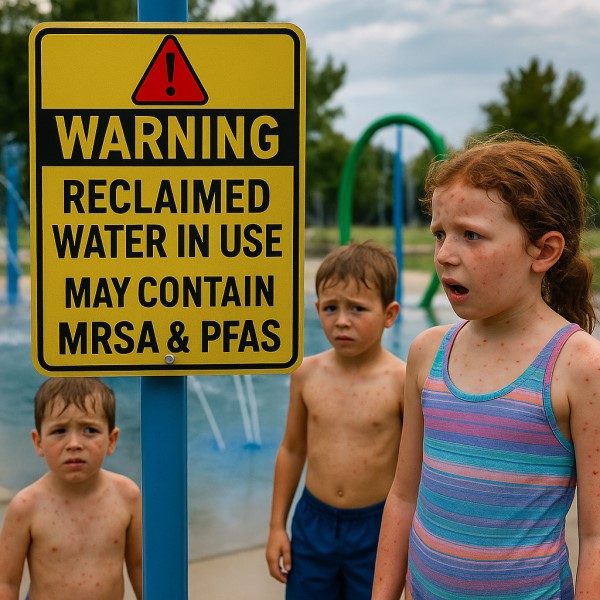 💩 Are You Playing in Crap Water? MRSA, PFAS, and What Pinal County Isn’t Telling You
💩 Are You Playing in Crap Water? MRSA, PFAS, and What Pinal County Isn’t Telling You
⚠️ Your kids and pets might be exposed to contaminated reclaimed water every day
Across Pinal County—San Tan Valley, Maricopa, Casa Grande, Florence, Coolidge, Arizona City—city parks, HOA greenbelts, and splash pads are often irrigated with Class A or B reclaimed wastewater. This treated sewage comes from sources like toilets, showers, hospitals, and industrial processes.
Although technically permitted for non-potable use, scientific evidence shows it can harbor antibiotic‑resistant bacteria and other emerging contaminants.
🧫 MRSA and Antibiotic Resistance Are Real in Reclaimed Wastewater
- A CDC-supported study detected methicillin‑resistant Staphylococcus aureus (MRSA) in final effluent from wastewater treatment plants, along with other multidrug‑resistant bacteria.
[Read the study → CDC] - MRSA can survive on playground turf, surfaces, or splash pad structures for days or even weeks. Repeated exposure increases the risk of skin infections.
[CDC: MRSA prevention] - Reclaimed water often contains antibiotic resistance genes (ARGs) like mecA, vanA, sul1—even after disinfection. These can persist or regrow in distribution systems.
[NIH study on ARGs in treated water] - CDC research confirms environmental spread of antibiotic resistance is a top U.S. public health threat.
[CDC: AMR Facts]
💧 What’s Happening in Pinal County?
Reclaimed water only makes up about 0.5% of total water use in Pinal County—for now. But cities and developers are expanding its use fast—especially for HOAs, irrigation, and aquifer recharge under HB 2753.
Even though it’s labeled safe for non-drinking use, state permitting rules (Arizona Admin Code Title 18) were not written with MRSA or ARGs in mind. And neither ADEQ nor your HOA may be testing for them.
The CDC and peer-reviewed studies now show what wasn’t known in the early 2000s: this water can still make people sick, especially kids and immune-compromised individuals.
🔥 Why Every Pinal Resident Should Be Concerned
- You’re not being told. Most residents have no idea they’re paying HOA fees for parks sprayed with treated sewage.
- MRSA and other resistant bacteria can survive the treatment process.
- These bacteria can regrow in purple pipe systems between treatment and spray heads.
- HB 2753 allows this water to be pumped back into aquifers—possibly near your well.
🛑 What You Can Do Right Now
| 🚨 Action | ✅ Why It Matters |
|---|---|
| Ask your HOA or city if reclaimed effluent is used on parks or greenbelts | They are legally required to tell you if asked. Push for microbial test results. |
| Test your private well if near an effluent recharge zone | ADEQ doesn’t test private wells unless a complaint is filed. Be proactive. |
| Watch for ADEQ’s upcoming 2025 rule changes | Public comment is your chance to demand stronger reclaimed water protections. |
| Tell your doctor about frequent rashes, infections, or pet illness | Environmental MRSA exposure should be part of the diagnosis process. |
🔎 Coming Up Next in This Series
- Part 2: Who pushed HB 2753 — lobbyists, developers, and the Rose Law Group connection
⚠️ This Is Real Science — Not a Conspiracy
We’ve been told reclaimed water is “safe.” But the CDC, NIH, and peer-reviewed journals all confirm that antibiotic-resistant bacteria, genes, and pathogens can survive treatment and spread.
If your family is playing in it, and your aquifer could be recharged with it — you have a right to know and a right to say no.
Watchdog journalism matters. Keep reading PinalCountyNews.com and share this article.